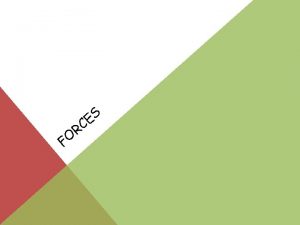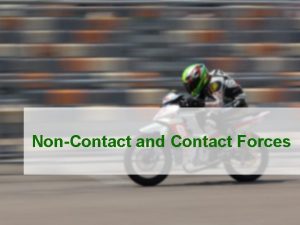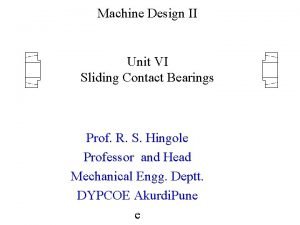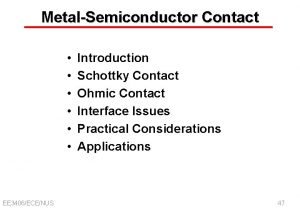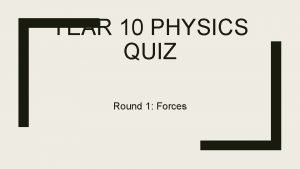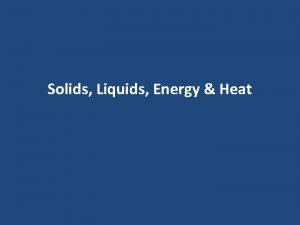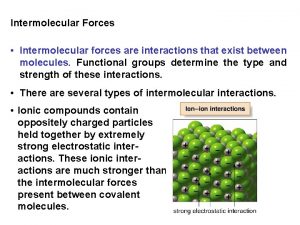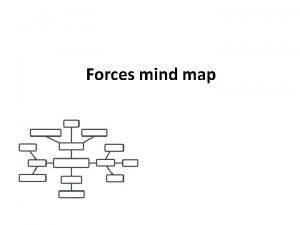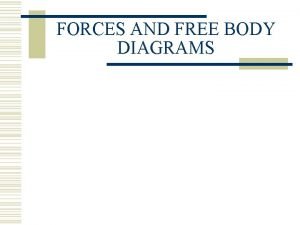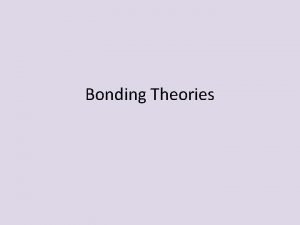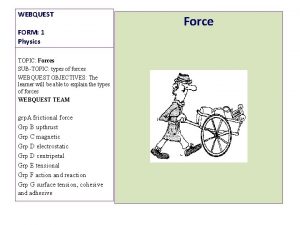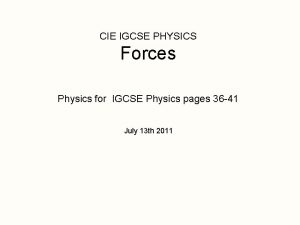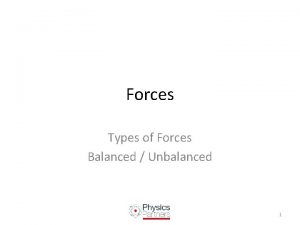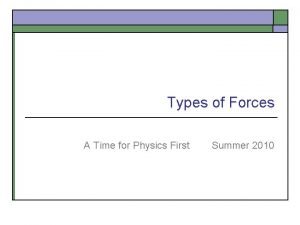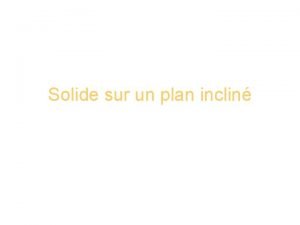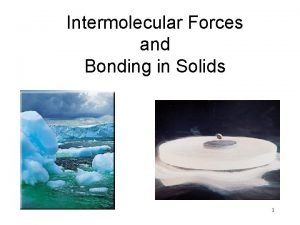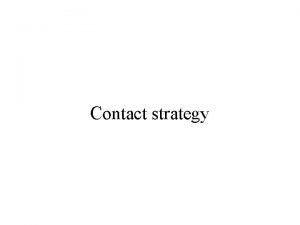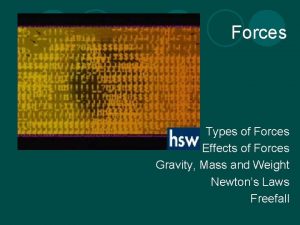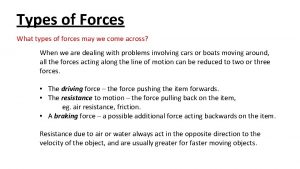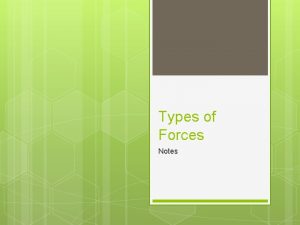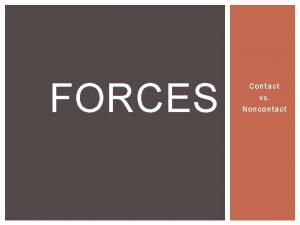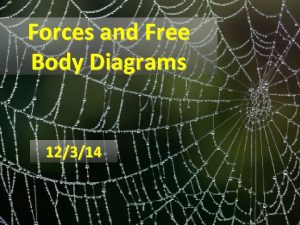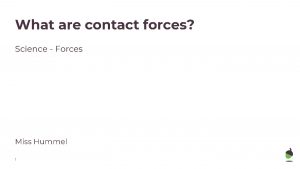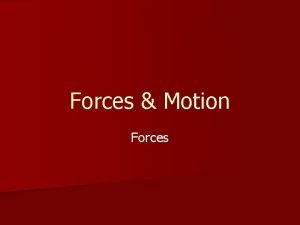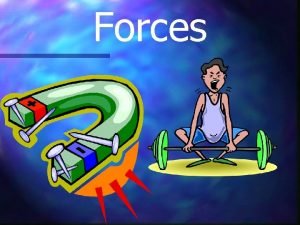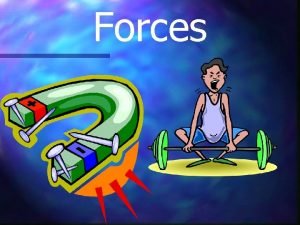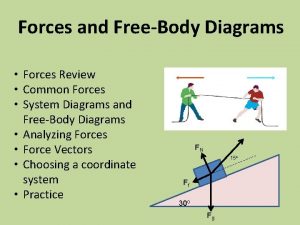Types of Forces Contact Forces Forces at a
































- Slides: 32

Types of Forces • Contact Forces • Forces at a distance.

Four Main Forces in Universe • • Gravity Fg. Electromagnetic EM Strong Nuclear Strong or Nuclear Weak • All Forces fall into one of the above categories.

Common Forces • Normal Force (reaction force) – • perpendicular to the surfaces in contact or touching.

What if you’re leaning on a wall. Where is the normal force?

Where is it now?

Sliding Friction – force acts at contact between surfaces. Direction of friction opposes velocity or attempted velocity. Which way is friction? Ff = m. Fn m is constant

Which way is the book moving? Right Left The box is not moving.

• Tension – • transmitted through string, rope, or wire by forces at each end.

Air Resistance – air friction. Big reason for bad fuel economy in cars.

Spring or Elastic Force – Force applied by stretched or compressed spring described by Hooke’s Law.

Magnetic Force – due to excess electron spin

Electrical – due to excess charge buildup.

• Weight Fg = mg • gravity interaction with mass. Weight depends on gravity, Mass does not. What is mass? Amount of matter in object.

Question: What will be the mass of a 10 -kg object on the moon? • • 1. Zero 2. Less than 10 – kg 3. 10 – kg. 4. Impossible to tell without more information.

Calculation of Weight Fg and mass. • g = Fg/m • Fg = mg. • Fg = gravity on object = weight N. • m = mass, kg. • g = accl gravity m/s 2. • On Earth g = 9. 81 m/s 2.

1. A student weighs 850 -N on Earth. What is his mass? • Fg = mg. • Fg = m • g • 850 N • 9. 81 m/s 2. • = 86. 6 kg

2. A 650 -N Earth student weighs 12. 6 N on planet Tessaz. What is the acceleration of gravity on Tessaz? • • Find mass on Earth. m = Fg/g m = 650 N/ 9. 81 m/s 2. m = 66 kg. g = Fg/m g = 12. 6 N/ 66 kg. g = 0. 2 m/s 2.

3. Little Jimmy weighs 490 -N on Earth. If the acceleration of gravity on Monster. Y is 50 m/s 2, what is the force of gravity on Little Jimmy on Monster. Y? • m = Fg/g • 490 N/9. 81 m/s 2. • m = 50 kg. • Fg = mg • (50 kg)(50 m/s 2) = 2500 N

3. Make a sketch graph of weight (Y) vs. mass (X). Write the equation for the graph. What is the slope of the line? 120 Weight vs. Mass 100 Weight N 80 60 40 20 0 0 2 4 6 Mass kg 8 10 12

Hwk Sheet 1 - 15.

Normal Force Fn. • Contact between surfaces. Fn • Always perpendicular to surface. • If object rests on horizontal surface, then: • Fn = -W = mg.

How does Normal Force Arise? How does a wall know to push back harder when I push with increasing force?

The object will be at rest only if the surface can exert an equal & opposite force to sustain it, otherwise the object crashes through the surface.

Friction Between Surfaces

Friction depends on the nature of the materials in contact and the smoothness of their surfaces.

. Friction is independent of surface area. . Ff is directly proportional the normal force. Ff = m. Fn. Where m is a constant. The ratio of Ff, to Fn, is the coefficient of friction, m. m= Ff Fn m has no units.

File Cabinet Demo

m • m depends on two surfaces in contact • the type of sliding motion – starting or moving. • Does not depend on any other factor. • It is a constant.

Types of Friction • Static Friction use mst – Present for objects at rest. Need to overcome to start objects moving. • Kinetic Friction or sliding use mk – Present for objects in motion. Need to overcome to keep objects in motion. Always less than static friction.

Reference Table

1. A 10 -kg rubber box is at rest on a dry horizontal concrete surface. Calculate: • a. the weight of the box. 98. 1 N • b. the normal force on the box. • c. the force needed to start the box moving. Ff = mst. Fn. = (0. 9 )98. 1 N = 88. 9 N • d. the force to keep the box moving a constant velocity. Ff = mst. Fn. = (0. 68 )98. 1 N = 66. 7 N

 Contact vs non contact forces
Contact vs non contact forces Contact vs field forces
Contact vs field forces Contact vs noncontact forces
Contact vs noncontact forces Contact and non contact forces
Contact and non contact forces Which force
Which force Machine design
Machine design Irritant vs contact dermatitis
Irritant vs contact dermatitis Whats a noncontact force
Whats a noncontact force Ohmic contact
Ohmic contact Post encounter stage
Post encounter stage Which of the following forces is a contact force? *
Which of the following forces is a contact force? * Inventor contact types
Inventor contact types Parallel force system example
Parallel force system example The forces shown above are pushing/pulling forces
The forces shown above are pushing/pulling forces Intramolecular forces vs intermolecular forces
Intramolecular forces vs intermolecular forces Difference between intramolecular and intermolecular
Difference between intramolecular and intermolecular Inter vs intramolecular forces
Inter vs intramolecular forces Force examples in everyday life
Force examples in everyday life What are constructive and destructive forces
What are constructive and destructive forces 3 types of intermolecular forces
3 types of intermolecular forces Concept of imfa
Concept of imfa Van der waals attraction
Van der waals attraction Concept map about intermolecular forces
Concept map about intermolecular forces Types of field forces
Types of field forces Sequence the steps in drawing a free-body diagram
Sequence the steps in drawing a free-body diagram Hybrid bonding
Hybrid bonding Types of forces in technology
Types of forces in technology Intermolecular forces webquest
Intermolecular forces webquest Igcse
Igcse Conclusion of force
Conclusion of force Fictional character
Fictional character Types de forces physique
Types de forces physique Network covalent
Network covalent



